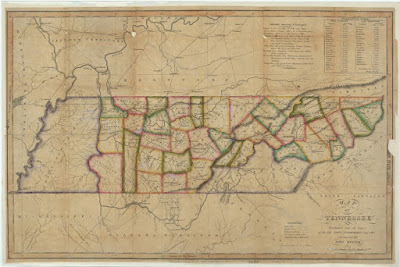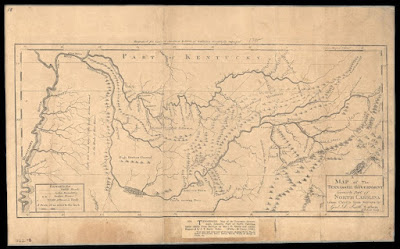By Taylor McPeake
 |
| Clipping from the Clarence Bowden Wyatt Papers, Tennessee State Library & Archives. |
Born Nov. 4, 1917, Clarence Bowden Wyatt grew up in Roane County, Tenn., wanting to play football at the University of Tennessee for Coach Robert Neyland. After playing for Roane County High School, including the 1933 undefeated team which held all their opponents scoreless, he entered the University of Tennessee in 1935. Wyatt wasn’t recruited to play for the Volunteers, but at the request of a high school teammate, he was offered the chance to play for the University he loved. He would go on to have an impressive career as an end for the Volunteers. His teammates voted him captain of the 1938 team. That same team finished the season undefeated and won the Orange Bowl over the University of Oklahoma. Tennessee won 17-0 with Wyatt kicking the field goal that sealed the win. During his playing career, he made the All-Conference team in 1937-1938 and was selected to the All-America team in 1938. After his playing days with the Volunteers ended, he turned down an offer to play professionally to begin his collegiate coaching career.
 |
| Clipping from the Clarence Bowden Wyatt Papers, Tennessee State Library & Archives. |
Wyatt began coaching at Mississippi State in 1939 as the end coach under Allyn McKeen, a former Volunteer. He coached the Bulldogs from 1939-1942 and again in 1946. Between 1943-1945, he served in World War II, becoming a lieutenant in the Navy. Wyatt landed his first head coaching job in 1947 at the University of Wyoming, where he led the Cowboys to victory in the 1949 and 1950 Skyline Conference championships. He stayed at Wyoming until 1953, when he became the head coach at the University of Arkansas. In just his second year at Arkansas, he shocked many by winning the Southwest Conference title and a trip to the Cotton Bowl. The Razorbacks lost the bowl game 14-6 to Georgia Tech, coached by Bobby Dodd, himself a former Volunteer football star.
 |
| Clipping from the Clarence Bowden Wyatt Papers, Tennessee State Library & Archives. |
After the head coaching position became available at the University of Tennessee in 1955, General Neyland, now the Athletic Director, handpicked Wyatt to be the head coach. He went on to have many successful years as the Tennessee coach, staying in the role until 1962. In his second season as coach, his 1956 team went undefeated but would lose to Baylor 13-7 in the Sugar Bowl. The team finished the season ranked second in the national polls. After the 1956 season, Wyatt was named “Coach of the Year” in the Southeastern Conference and nationally. Playing on that 1956 team was Johnny Majors. Majors had a legendary playing career at Tennessee from 1954-1956. Prior to a game against the University of North Carolina in 1955, Coach Wyatt said, “Johnny Majors has taken charge of things on the field. Not only has that helped the team as a whole but it has helped him individually. He’s the boss on the field and he knows it.”
Both men were involved in arguably one of the greatest games in the history of college football. On Nov. 10, 1956, the undefeated, third-ranked Tennessee Volunteers played the undefeated, second-ranked Georgia Tech Yellow Jackets in Atlanta in a game that would be remembered for its defense. Tennessee won the game 6-0, with Majors throwing the pass that led to the only score of the game. Majors would finish as runner-up to the Heisman Trophy after the season. When Majors’s playing career was over, following a short time in the Canadian League, he started his coaching career as an assistant coach under Wyatt. Majors coached at Tennessee from 1957-1959 before leaving in 1960. Majors returned as head coach of the Volunteers in 1977 and coached them through the 1992 season, cementing his legendary status as a Tennessee player and coach. Later in life, Majors talked about the great coaching he received as a player from Wyatt and his staff.
 |
| Clipping from the Clarence Bowden Wyatt Papers, Tennessee State Library & Archives. |
At Tennessee, Wyatt had an overall record of 49-24-4. He had winning seasons in all but two years. His overall coaching record was 99-56-5. Upon General Neyland’s death in 1962, Wyatt was named the acting Director of Athletics. In this role, he made a lasting impact on all fans of the Volunteers with his hiring of Ray Mears as head coach of the men’s basketball team. Mears was head coach from 1962-1977 and, during his tenure, he coined the phrase “Big Orange Country” and got fans to start wearing orange at more than just football and basketball games. He also had his teams run through a giant “T” onto the court, a tradition adopted by the football team on the field. Following a short stint as assistant coach at Oklahoma State University, Wyatt retired to Roane County with his wife Mary Miller, who he met at Tennessee and married in 1940. He enjoyed living a quieter life in the country but missed coaching and working with the players. He continued to go to many Tennessee football games. He died on Jan. 21, 1969, and was buried in Roane County. Wyatt was posthumously inducted into the College Football Hall of Fame in 1972 as a player and again in 1997 as a coach, the Tennessee Sports Hall of Fame in 1972, and the Tennessee Athletics Hall of Fame in 2016. Wyatt’s contributions to Tennessee, both the University and the state, can best be summed up by Dr. A. D. Holt, the University of Tennessee President, speaking about Wyatt after his death,
“As an outstanding student leader, athlete, and coach at U-T, he contributed richly to the traditions of the Volunteers. He came to U-T as an unknown farm boy seeking a college education and, by his determination and dedication, gained national eminence in college football. The name of Bowden Wyatt will always be synonymous with moments of greatness in Tennessee Athletics.”
 |
| Clipping from the Clarence Bowden Wyatt Papers, Tennessee State Library & Archives. |
To learn more about this accomplished player and coach, come to the Tennessee State Library & Archives and ask for the Clarence Bowden Wyatt Papers, Clarence Bowden Wyatt Papers, 1937-1989. The collection contains newspaper clippings, programs, and many other items documenting his illustrious career. We’re located at 1001 Rep. John Lewis Way North, on the northeast corner of the Bicentennial Capitol Mall State Park in Nashville. The Library & Archives is open to the public from 8 a.m. to 4:30 p.m. CT Tuesday through Saturday. If you have questions about the Clarence Bowden Wyatt Papers, the Library & Archives, or our resources, please email ask@tsla.libanswers.com or call 615-741-2764 for assistance.
ADDITIONAL SOURCES AND RELATED LINKS:
- “Bowden Wyatt,” National Football Foundation Hall of Fame, https://footballfoundation.org/hof_search.aspx?hof=1827
- John T. Majors Papers, 1952-1995, https://tnsla.ent.sirsi.net/client/en_US/search/asset/20388/0
- John T. Majors Scrapbooks, 1939-1991, https://tnsla.ent.sirsi.net/client/en_US/search/asset/122061/0
- John T. Majors: Tennessee Football Legend and Player and Coach (online exhibit): https://sharetngov.tnsosfiles.com/tsla/exhibits/majors/exhibit_majors.htm
The Tennessee State Library & Archives is a division of the Office of Tennessee Secretary of State Tre Hargett.















